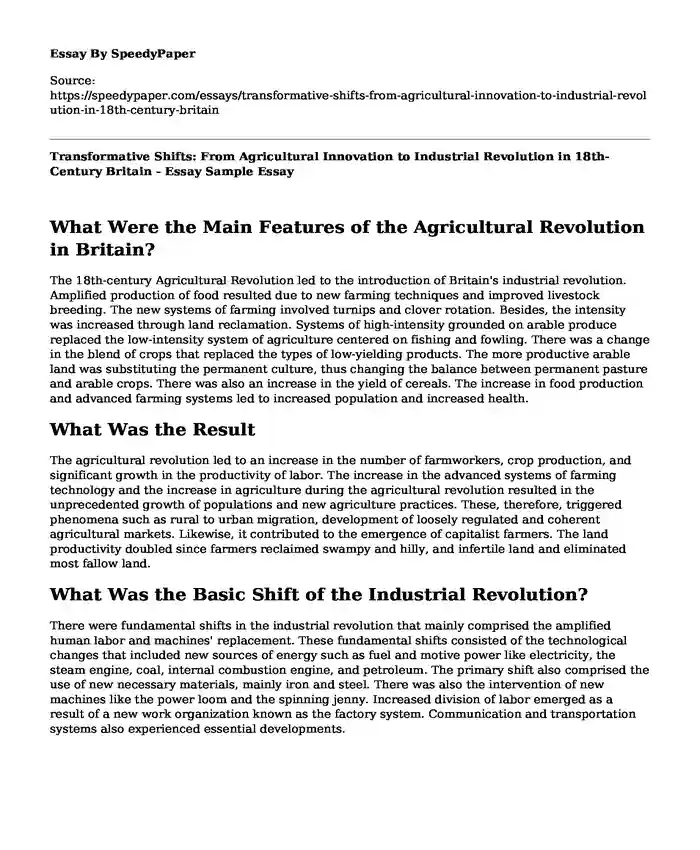
| Type of paper: | Essay |
| Categories: | History Agriculture Industrial revolution Historical events & places |
| Pages: | 4 |
| Wordcount: | 835 words |
What Were the Main Features of the Agricultural Revolution in Britain?
The 18th-century Agricultural Revolution led to the introduction of Britain's industrial revolution. Amplified production of food resulted due to new farming techniques and improved livestock breeding. The new systems of farming involved turnips and clover rotation. Besides, the intensity was increased through land reclamation. Systems of high-intensity grounded on arable produce replaced the low-intensity system of agriculture centered on fishing and fowling. There was a change in the blend of crops that replaced the types of low-yielding products. The more productive arable land was substituting the permanent culture, thus changing the balance between permanent pasture and arable crops. There was also an increase in the yield of cereals. The increase in food production and advanced farming systems led to increased population and increased health.
What Was the Result
The agricultural revolution led to an increase in the number of farmworkers, crop production, and significant growth in the productivity of labor. The increase in the advanced systems of farming technology and the increase in agriculture during the agricultural revolution resulted in the unprecedented growth of populations and new agriculture practices. These, therefore, triggered phenomena such as rural to urban migration, development of loosely regulated and coherent agricultural markets. Likewise, it contributed to the emergence of capitalist farmers. The land productivity doubled since farmers reclaimed swampy and hilly, and infertile land and eliminated most fallow land.
What Was the Basic Shift of the Industrial Revolution?
There were fundamental shifts in the industrial revolution that mainly comprised the amplified human labor and machines' replacement. These fundamental shifts consisted of the technological changes that included new sources of energy such as fuel and motive power like electricity, the steam engine, coal, internal combustion engine, and petroleum. The primary shift also comprised the use of new necessary materials, mainly iron and steel. There was also the intervention of new machines like the power loom and the spinning jenny. Increased division of labor emerged as a result of a new work organization known as the factory system. Communication and transportation systems also experienced essential developments.
What Geographic, Economic, Natural, and Financial Factors Enable Britain to Become the First Industrialized Nation in the 1800s?
The location of the coal deposits in Britain is one of the main geographical factors behind Britain becoming the first industrialized nation. Britain's coal deposits were easily accessible, and navigable waterways eased the transportation of coal to urban areas. Coals deposits seemed to be near the navigable rivers. The vast deposits of coal were used to power new machines. This helped in making industrialization possible
Besides, the economy of Britain was much less regulated as compared to the economies of other nations. The relatively system of laissez-faire enhanced the development of innovation of the sort that contributed to used technology in the industrial revolution. It was easier for businesses to thrive in Britain due to its relatively domestic conflict-free nation. The peasants were successfully pushed off the land by the British landlords. The peasants became significant in supplying labor that could provide the workforce to the emerging factories during the industrial revolution in Britain.
The natural resources such as coal and iron were abundant. Few regulations on agricultural or industrial workers allowed them to shift where it seemed best for them. This contributed to the nation's industrial revolution.
The bank of England provided financial support for the projects. The bank provided a strong anchor for a credit system with lower interest rates than most European countries. There was a continuous increase in the number of banks that provided financial support for Britain's industrial revolution.
What Were the Specific Inventions of the 1700s That Revolutionized Textile Manufacture in Britain?
Textile manufacturing in Britain triggered tremendous scientific innovations that led to the emergence of the explicit inventions such as the water frame, spinning jenny, flying shuttle, and the spinning mule. These inventions led to productivity improvement and drove further technological advancements that turned textile into a fully mechanized industry.
Trace the Related Development in Iron-Making, Transportation, and Steam Power.
Iron replaced wood as the material for making the industrial tools and machines. The increase in the industrial revolution led to an increased demand for coal. Coal provided power for the steam-powered ships, factory engines, and steam locomotives. It, therefore, led to an increased demand for iron.
The steam engine improved transportation. It was either used as part of a train or on its own. The steam engine is, therefore, the iconic invention of the industrial revolution. The steam engine technology helped huge power factories, enhanced deeper mines, and evolved the transportation network. The steam power might be the Industrial Revolution icon even though it had little impact in the initial stages since it was only applicable to large scale industrial processes. The steam power helped in launching the industrialization and also aiding in shifting industrialization to rural areas.
Works Cited
Hazy. "The Industrial Revolution: A General Essay." The Industrial Revolution and Economic Growth, 2017, pp. 108–130., https://doi.org/10.4324/9781315172132-7.
Cite this page
Transformative Shifts: From Agricultural Innovation to Industrial Revolution in 18th-Century Britain - Essay Sample. (2024, Jan 03). Retrieved from https://speedypaper.net/essays/transformative-shifts-from-agricultural-innovation-to-industrial-revolution-in-18th-century-britain
Request Removal
If you are the original author of this essay and no longer wish to have it published on the SpeedyPaper website, please click below to request its removal:
- EU Enlargement - Free Essay on Security Matters
- Economics Paper Example: Microeconomic Reasons for Government Involvement
- Essay Example on Effects of Falling Value of Euro
- French Revolution Essay Sample for Your Inspiration
- Exploring Chicago History: 1856 Chicago History Museum Exhibitions - Essay Sample
- The US: A Long and Varied History of Sweets and Bitters - Essay Sample
- The Danube Crisis under Valentinians Rule - Essay Sample
Popular categories




